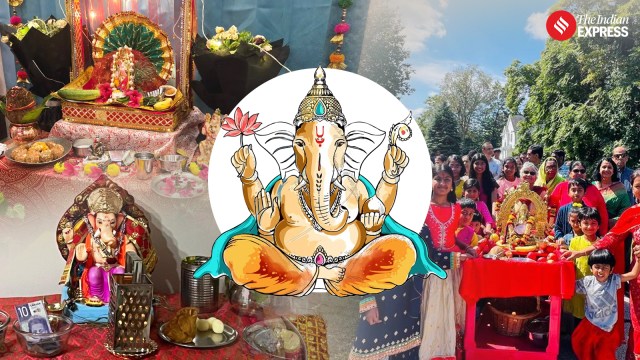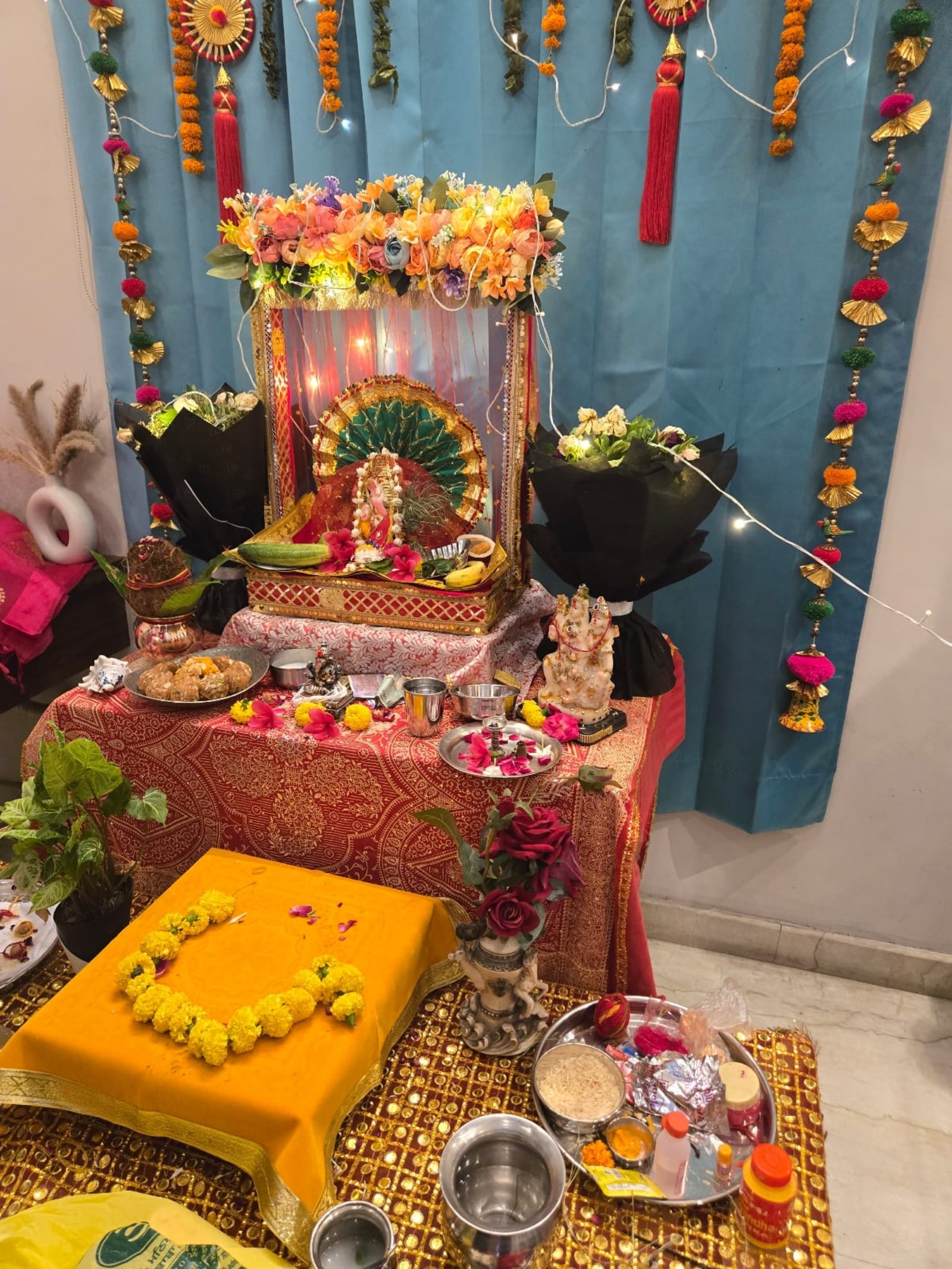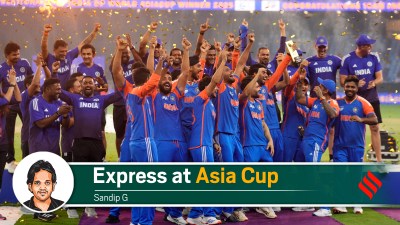In the small, remote town of St. George, Utah, a spirited gathering of about 75 people — mostly strangers until that day — came together to celebrate Ganesh Chaturthi, a festival deeply rooted in Indian tradition but now flourishing far from its homeland.
Arindam Sharma, a cardiologist, vividly recalls the event. “My wife and I have been living here for a few years, far from the familiar sounds of India. But this festival brought us all together.”
“A Maharashtrian family had set up Ganpati at home, then brought Him to a hotel conference hall. We performed the aarti, danced the Garba, and even had a small, improvised visarjan in a container of water. For a few hours, it felt like we were back in India,” he says.
For Sharma, and many like him, this humble celebration reflects a growing phenomenon: Ganesh Chaturthi has become a global affair.
Ganesh Chaturthi, as we know it today, owes much to Lokmanya Bal Gangadhar Tilak, who in 1893 transformed it from a private, familial event into a public celebration that galvanised Indian society. Before that year, the festival used to be a one-day affair, observed mainly by Brahmin families. Tilak recognised the festival’s potential to unify diverse sections of society, particularly in Mumbai’s chawls, where people of various castes and communities lived in close quarters.
This year, Mumbai’s first Ganeshotsav, which was held at Keshavji Naik Chawl in 1893 turned 132. Mangesh Pokle (President) and Kumar Walekar (Secretary), members of the working committee organising the mega celebrations at the chawl, say, “At Tilak’s urging, his associates, Rao Bahadur Limaye and Narahari Shastri Godse, organised the festival here. Tilak’s idea was not just about devotion; it was about creating a platform for social gathering and political discourse under British rule. Now, the tradition that once sparked India’s independence movement continues to bind our community together, not just in Maharashtra, but across state and national borders.”
“Tilak understood that festivals imbued with religious and cultural symbolism could serve as powerful platforms for political mobilisation,” says Dr Ganesh Chandanshive, Associate Professor at Lokkala Academy, University of Mumbai, adding that the festival offers a chance for people to reconnect with friends and share both the joys and struggles of life.
Story continues below this ad
Today, Ganesh Chaturthi in Mumbai is synonymous with grandeur, especially through the iconic “Lalbaugcha Raja.” Known as “Navasacha Ganpati,” or the wish-fulfilling Ganesha, it draws millions of devotees every year.
From Lalbaugcha Raja to Canadacha Raja
For Indians living abroad, festivals like Ganesh Chaturthi offer more than just a taste of home — they create a sense of unity and belonging. Dr Maria Johar, a physician in Ohio, noted how the festival’s appeal transcends regional and linguistic divides.“The Ganpati festival is celebrated all over the USA. It’s huge for us, and it doesn’t matter if you’re from the North or South of India. Everyone comes together. We’re one community.”
Shuchi Khaitan, a chartered accountant, who has been living in Toronto for over a year, always saw the grandeur of Ganpati celebrations in films and on TV but never had the chance to participate until she moved here. “This year, my mother in Delhi also got Ganpati for the first time, which points to a growing trend,” she says.
Asked how popular the festival is in Canada, Khaitan says, “We went to purchase our Ganpati, a week before the festival, but the shopkeeper said he had already sold 5,000 idols and another thousand in the warehouse were already booked.”
Story continues below this ad
 Ten dollars and a bowl-full of chocolate toffees being offered to Lord Ganesha in Canada. (Photo: Shuchi Khaitan)
Ten dollars and a bowl-full of chocolate toffees being offered to Lord Ganesha in Canada. (Photo: Shuchi Khaitan)
Inspired by Lalbaugcha Raja, Toronto boasts of a ‘Canadacha Raja’, a 16-foot-tall Ganpati idol, reportedly the tallest in Canada. It is imported from India. “The Visarjan takes place in a lake, with devotees taking a boat for a fee of 50 Canadian dollars,” says Khaitan.
Manisha Singh, based in Dallas, Texas, shares her experience. “I was born and raised in Jamshedpur, where Ganesh Chaturthi was a homely affair with family and close relatives. Over the years, I’ve noticed a significant change in its popularity, largely due to social media. It has become a trend to participate in grand celebrations, and many people now join in the festivities.”
Singh, who has been in Dallas for about seven months, celebrated Ganesh Chaturthi for the first time in the US this year. “I maintained my traditional approach and celebrated at home with my husband and our 2-year-old toddler,” she says. She notes that the celebrations in Texas included numerous Ganapati puja events across various neighbourhoods, fairs with Indian food, sweets, and games for kids.
For Gopal Langalia, a long-time resident of Sydney and active member of the International Swaminarayan Satsang Organisation, festivals like Ganesh Chaturthi help the diaspora to engage with the wider community. “The festival serves as a bridge, introducing non-Indians to Indian culture while bringing Indians closer together,” he says.
Story continues below this ad
Grand homecoming across India
Back in India, even in smaller cities, Ganesh Chaturthi is becoming increasingly popular. Geeta Thakur, a retired teacher from Shimla, reflects on this cultural shift. “Growing up, we never really saw Ganesh Chaturthi being celebrated here with much fanfare,” she recalls. “But in the last five or six years, it has become popular. Now there are at least two to three pandals in places such as Middle Bazaar, Ram Bazaar, and Sanjauli. People bring Ganpati home with great reverence, hold aartis, and conduct eco-friendly Visarjans.”
 A pandal decorated by the Ohri family in Jalandhar, Punjab. (Photo: Shubhangi Ohri)
A pandal decorated by the Ohri family in Jalandhar, Punjab. (Photo: Shubhangi Ohri)
Jalandhar-based teacher Shubhangi Ohri says Ganeshotsav has gradually ingrained itself into local culture. “Earlier, we only celebrated Navratri, Durga Puja, and Diwali on a grand scale. Now, Ganeshotsav has also become very popular, with almost every second house bringing in Ganpati. This year, we too bought a biodegradable Ganpati for the first time as our family is starting a new business venture.”
Bollywood, migration, and nostalgia
So how did a festival rooted in local traditions manage to grow into a global celebration?
GN Devy, a literary critic and cultural activist, says that festivals involving deities with an image become popular across continents as they evoke a sense of nostalgia. Iconography plays an important role in the popularity of deities, take Lord Krishna. A similar trend has been observed in the growing popularity of Chhath Puja across continents. Ganesh is all the more popular given its sanctity in the Mahabharata, though once a Brahmanical God, now his worship has transcended caste and community.
Story continues below this ad
Devy also alludes to the socio-political reasons for the festival’s growing popularity in India and abroad saying “political currency” has been woven into the festival. “Once upon a time, the Lalbaugcha Raja Ganeshotsav celebrations were almost entirely funded by factory workers, but now mostly political parties fund the celebrations.”
 The Indian diaspora comes together in Toledo Ohio, to bring home Ganesha in a foreign land. (Photo: Dr Maria Johar)
The Indian diaspora comes together in Toledo Ohio, to bring home Ganesha in a foreign land. (Photo: Dr Maria Johar)
Neela Lad, former deputy director general, Ministry of Tourism, credits the migration of Maharashtrians to other parts of India and abroad for spreading the tradition. “Ganesh Chaturthi, traditionally celebrated in Maharashtra, owes its global spread to a mix of migration and cultural significance. The Maharashtrian diaspora took the festival with them, whether to cities like Delhi or far-off countries. But it’s not just the Maharashtrians, countries like Thailand and Cambodia have long revered Ganesha, and this shared reverence has helped the festival resonate internationally. Plus, Ganesha’s role as the remover of obstacles is a universal concept.”
The festival’s leap from local streets to international stages wasn’t just about geography, it was also about modern media. “Bollywood has played a huge role in popularising Ganeshotsav,” Lad continues. “Think about how many films have showcased the grand spectacle of Ganesh Chaturthi, from the high-energy aartis to the emotional immersion processions. Social media platforms have only amplified this, letting devotees in different parts of the world feel connected in real-time.”
On the influence of pop culture, Rahul Mitra, a filmmaker, says, “Hindi films have a history of using religion and festivals as powerful backdrops. Ganesh Chaturthi is one of those festivals that captures joy, devotion, and excitement in one grand visual. It’s not just about faith—it’s about celebration.”
Story continues below this ad
Dr Chandanshive, adds another perspective. “It’s not just cinema and social media. Historically, the jewellers from Maharashtra who migrated to Delhi and other parts of India were instrumental in making Ganeshotsav a pan-Indian event. They brought the festival with them, and from there, it spread like wildfire. Over time, as people moved abroad, so did the celebration.”
He also credits Maharashtra’s talented shahirs — traditional folk singers known for their devotional songs — for helping popularise Ganeshotsav far beyond its birthplace. “Their songs in praise of Ganpati were powerful, and their influence lingered as the festival moved to different parts of the world.”
The rise of Ganesh Chaturthi as a global festival is a testament to the power of culture, community, and connectivity. From a Maharashtrian tradition to a worldwide celebration, Ganeshotsav’s journey reflects the evolving nature of festivals in a modern, interconnected world.



 Ten dollars and a bowl-full of chocolate toffees being offered to Lord Ganesha in Canada. (Photo: Shuchi Khaitan)
Ten dollars and a bowl-full of chocolate toffees being offered to Lord Ganesha in Canada. (Photo: Shuchi Khaitan) A pandal decorated by the Ohri family in
A pandal decorated by the Ohri family in  The Indian diaspora comes together in Toledo Ohio, to bring home Ganesha in a foreign land. (Photo: Dr Maria Johar)
The Indian diaspora comes together in Toledo Ohio, to bring home Ganesha in a foreign land. (Photo: Dr Maria Johar)





